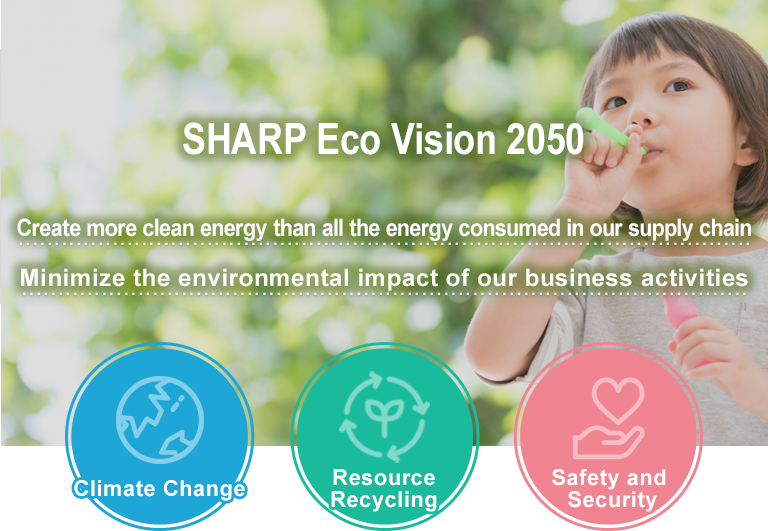Environmental Vision


SHARP Eco Vision 2050 Long-term Environmental Vision
The international community has recognized the urgent need to address increasingly serious environmental problems, such as climate change, resource depletion, and plastic pollution. This awareness is accelerating global action to solve these social problems, including efforts associated with the achievement of the Sustainable Development Goals (SDGs) and carbon neutrality*1, and the creation of a circular economy*2.
In 2019 Sharp formulated SHARP Eco Vision 2050, a long-term environmental vision based on its Basic Environmental Policy of “Creating an Environmentally Conscious Company with Sincerity and Creativity,” which was established in 1992. Sharp is working toward realizing a sustainable global environment by pursuing long-term goals set in three fields of action with 2050 as the target year: climate change, resource recycling, and safety and security.
In the field of climate change, while keeping in mind the 1.5°C target*3 stipulated in the Paris Agreement, Sharp aims to become carbon neutral in its business activities. It also seeks to broaden and disseminate clean energy-related products and services and to reduce greenhouse gas emissions from its products and services.
In the resource recycling field, Sharp pursues a circular economy by endeavoring to use recycled materials in all product parts and to achieve zero final landfill disposal from its business activities.
In the safety and security field, Sharp strictly manages chemical substances that may affect people’s health, the natural environment, and ecosystems and restricts their use to eliminate the risk of negative effects.
To accelerate our efforts toward the long-term environmental vision, Sharp is formulating medium-term environmental goals that define specific activities and quantitative targets in each field. To address climate change, Sharp aims to achieve net zero CO2 emissions from its business activities by 2050, with interim reduction targets of 40% by 2030 and 60% by 2035.
Sharp is aiming to solve social problems and continuously boost corporate value by deepening ties with stakeholders through business activities and environmental conservation efforts.
- *1 Subtracting the amount of absorption from the amount of greenhouse gas emissions, so that the total is effectively zero.
- *2 An economic system aimed at eliminating wastes and circulating resources. Waste products and raw materials are considered new resources and are thus recycled.
- *3 The Paris Agreement sets forth the long-term targets of keeping the rise in global average temperature well below 2°C above pre-industrial levels and pursuing efforts to limit the temperature increase to 1.5°C.
Long-term Environmental Goals
To bring about SHARP Eco Vision 2050, we have stipulated long-term goals in three fields of action. In pursuing these goals, we will strive to create more clean energy than the total amount of energy consumed in Sharp’s entire supply chain, while minimizing the environmental impact of our business activities.
Climate Change
Sharp has up to now striven to use less energy in its business activities and to make products that are increasingly more energy efficient so as to reduce the amount of energy consumed by households and society as a whole.
We began developing solar cells after founder Tokuji Hayakawa said, “All the products we make use electricity. As our company grows, we will need more electricity, so why don’t we make electricity ourselves?” Since then, we have spent more than half a century working to spread solar power generation.
It is precisely because Sharp makes products that use electricity that we have a responsibility to reduce the environmental impacts resulting from this electricity use.
By promoting the world goal of carbon neutrality, Sharp is taking on the challenge of achieving the following two goals by 2050 and thus becoming carbon-free throughout its supply chain, including its own business activities.
- Goal
-
- Achieve net zero CO2 emissions in Sharp business activities.
- Create more clean energy than the total amount of energy consumed in Sharp’s entire supply chain.
Resource Recycling
Sharp has up to now provided the world with all kinds of value through the creation of new products. At the same time, we have used many resources to do so.
Sharp should continue to provide its stakeholders with all kinds of value by making the most efficient use of finite resources around the globe.
By making more efficient use of resources and continuing to offer maximum value with minimal resources, Sharp is taking on the challenge of achieving the following two goals by 2050 and thus building a circular economy and realizing a recycling-oriented society.
- Goal
-
- Use no newly extracted resources* for making products.
- Achieve zero final disposal to landfill of waste generated in Sharp business activities.
Safety and Security
Sharp uses various chemicals in production processes in its factories, and the products themselves contain various chemicals. Such chemicals must be strictly managed because some of them can have negative effects on people’s health, the natural environment, or ecosystems.
Sharp’s business activities must not have a negative effect on people’s health, the natural environment, or ecosystems.
As well as complying with current international standards, Sharp has established its own even stricter in-house standards. Under these far-sighted standards, we thoroughly manage relevant chemicals with the goal of eliminating any negative effects that chemicals may have on people’s health, the natural environment, or ecosystems.
- Goal
-
- Properly manage chemicals in order to protect people’s health, the natural environment, and ecosystems.
- * Excludes those not suitable for recycling from an environmental standpoint.